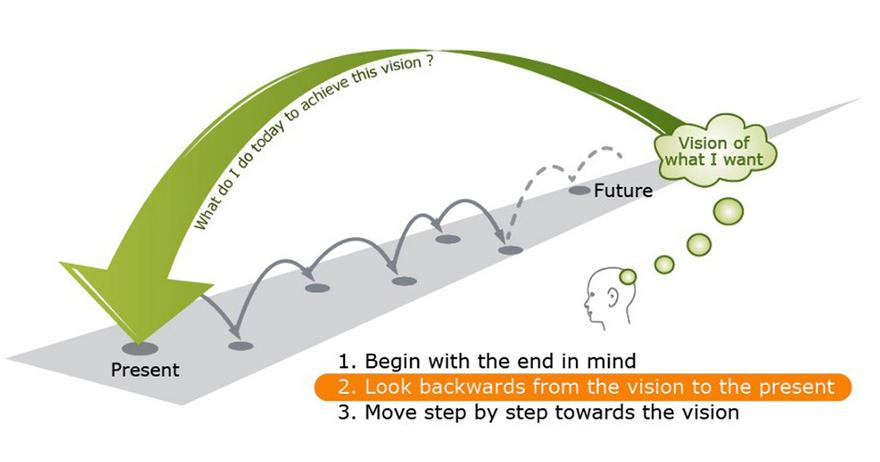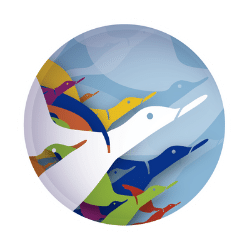Envisioning a future that works for all: characteristics of the visioning process

The vision of a sustainable human civilisation must be meaningful enough to be desired by everyone. This is an excerpt from the Worldview dimension of GEDS.
By Dr. Daniel Christian Wahl |
“Vision without action is useless. But action without vision does not know where to go or why to go there. Vision is absolutely necessary to guide and motivate action. More than that, vision, when widely shared and firmly kept in sight, brings into being new systems.” – Donella Meadows (Meadows et al., 1992, p.224)
Visions are like powerful lighthouses of a desirable future, guiding us on our way across uncharted seas. We hardly ever travel to the lighthouse directly, but sail towards it only to pass by it on our way to other places. The point is not to create a fixed vision and spend decades working towards manifesting exactly that vision. As we are approaching what we have envisioned, the vision may have changed and evolved into something else. Nevertheless visions can help us to make sure we are going in the right direction.
It is important to understand that in the process of creating a vision for a sustainable community, society, culture and civilisation we should not be restricted by what may be perceived right now as insurmountable obstacles to achieving that vision. The initial formulation of a vision has to be idealistic, creative, poetic, aesthetic, ethical, intuitive and imaginative. Rational reasoning from a particular perspective should not restrict the integrative and participatory process of creating the initial vision.
First, the best-case scenario, the ‘have our cake and eat it’ option, the win-win-win optimal future state has to be clearly described and en-visioned. This creates a collective goal desirable to everyone and therefore provides the basis for engaging the participation of diverse stakeholders in the long-term process of turning such a vision into reality through appropriate design.
While scenario planning and forecasting are ways to look at the trends we observe in the present and extrapolate them to the future, the visioning process first creates an ideal future state as clearly has it can be envisioned collectively. Only after the vision has been formulated in detail do we ask the question how we might get from where we are now to achieving our vision. This can also be done through a process of backcasting from that future state.
[This article is an excerpt from the Worldview Dimension of Gaia Education´s online programme in Design for Sustainability. The course is based on four dimensions plus a design studio. I wrote this course for Gaia Education in 2012 and revised and updated this dimension in 2016.]
In this section we will take a closer look at the key characteristics of collective visioning, explore the common steps shared by a variety of different visioning processes, and learn from some guidelines for successful vision building. Here are some organisations involved in visioning and world futures:
The International Futures Forum:
“restores practical hope and provokes wise initiative in challenging circumstances.”
World Future Council:
“we endeavour to bring the interests of future generations to the centre of policy making. We inform policy makers about future just policies and advise them on how to implement these. Political solutions for the challenges of our time exist.”
The Club of Rome:
“was founded in 1968 as an informal association of independent leading personalities from politics, business and science, men and women who are long-term thinkers interested in contributing in a systemic interdisciplinary and holistic manner to a better world.”
The Club of Amsterdam:
“is an independent, international, future-oriented think tank involved in channelling preferred futures.” The Club of Budapest: “Founded in 1993, the global Club of Budapest is an informal international association dedicated to developing a new way of thinking and a new ethics that will help resolve the social, political, economic, and ecological challenges of the 21st century.”
The Club of Budapest:
“Founded in 1993, the global Club of Budapest is an informal international association dedicated to developing a new way of thinking and a new ethics that will help resolve the social, political, economic, and ecological challenges of the 21st century.”
The World Policy Institute:
is “among the world’s leading think tanks, identifies critical emerging global issues in an interdependent world and gives voice to compelling new global perspectives and innovative policy solutions.”
The World Watch Institute:
“delivers the insights and ideas that empower decision makers to create an environmentally sustainable society that meets human needs. Worldwatch focuses on the 21st-century challenges of climate change, resource degradation, population growth, and poverty by developing and disseminating solid data and innovative strategies for achieving a sustainable society.”
The Heinrich Böll Stiftung:
“We are a political non-profit organisation striving to promote democracy, civil society, equality and a healthy environment internationally. Headquartered in Berlin/Germany, the Heinrich Böll Stiftung has 28 offices worldwide and cooperates with more than 200 partners in more than 60 countries.”
The Tällberg Foundation:
“is an independent non-profit organisation that designs learning processes in the pursuit of new creative ideas and understanding of the wider context.”
Forum for the Future:
“is a non-profit organisation working globally with business and government to create a sustainable future. We have 15 years’ experience inspiring new thinking, building creative partnerships and developing practical innovations to change our world. We aim to transform the critical systems that we all depend on, such as food, energy and finance, to make them fit for the challenges of the 21st century.”
“Visioning is more than painting an idealistic picture of the future — it is a process of evaluating present conditions, identifying problem areas, and bringing about a community wide consensus on how to overcome existing problems and manage change. By learning about its strengths and weaknesses, a community can decide what it wants to be, and then develop a plan that will guide decisions towards that vision. … Having a shared vision allows a community to focus its diverse energies and avoid conflicts in the present as well as the future.” — Alan Sandler (2000, p.216)
Here is a 6 minute video of Robert Costanza explaining a 4 scenario approach to different types of possible futures and ending up with a clear reason why we should spend more time envision ‘Eco-topia’ — a truly visionary future that works for all, rather than get too bogged down in a more forecasting type approach to future visioning that is limited by pessimistic extrapolation of existing trends today.
The value of creating a vision lies in the way it connects the future and the present. First, a vision helps us to put our current behaviour into context and perspective, and second, it “catalyses new actions and partnerships in order to move the community or organisation towards the future it wants” (Baxter & Fraser, 1994, p.4). Seaton Baxter and Bruce Fraser identify six main characteristics of visioning which make it a uniquely useful process. These are summarised in the table below:
Characteristics of the Visioning Process (Adapted after Baxter & Fraser, 1994, pp.4–5)
- Visioning operates on a long time scale. Thinking longer term than about 5–10 years is often a difficult exercise — even strategic planning is often not long-term but reactive and short-term. Visioning, however, generally aims to focus 25 years plus from the present.
- Visioning is a participatory process. The vision should be a shared one and not that of an individual, as no one person can vision for the whole community of interests. Ownership of the vision, and hence commitment to it, must be shared as widely as possible and this process is one of building consensus.
- Visioning helps to identify prioritised or preferred outcomes. The vision answers the question “What do we want?” It is not simply a process of forecasting what is likely in the future. It must be the future that is wanted and this may differ from a forecast or likely scenario of the future. It is also different from “What do we want to avoid?” Negative visions are limiting as energy is directed towards preventing something from happening rather than building something new, and the energy and vision often lasts only as long as the threat persists (Senge, 1990).
- Visioning requires and trains a holistic perspective. The vision must recognise the systemic linkages and interconnectedness of many of the aspects and forces that will affect the future and seek to integrate these. It is not a vision of a particular sector of the community.
- Visions are untestable in the present. There is no ‘right’ or ‘wrong’ vision for the future as no-one can predict what the future will be or what is possible or impossible for certain. The process of visioning recognises the fundamentally unpredictable and uncontrollable nature of complex dynamic systems.
- Visioning is a motivational and action oriented process. The visioning process should lead to individual and collective action in order to move the present situation towards the future vision which has been developed. Real commitment to a shared vision will foster action and innovation.

The vision of a sustainable human civilisation expressed by diverse regenerative cultures carefully adapted to the bio-cultural uniqueness of the places they inhabit] must be meaningful enough to be desired by everyone. So much so, that it motivates all global citizens and their communities to engage in local, regional, and global cooperation in driving the long-term process of turning vision into reality. Only together and in collaboration will we be have to co-create a future that works for all.
This is an excerpt from the Worldview dimension of Gaia Education’s online course in Design for Sustainability, written by Dr Daniel Wahl, with contributions from Ross & Hildur Jackson and Will Keepin. It was first written in 2012 and reviewed and updated in 2016.



0 comments
Leave a comment
Please log in or register to post a comment